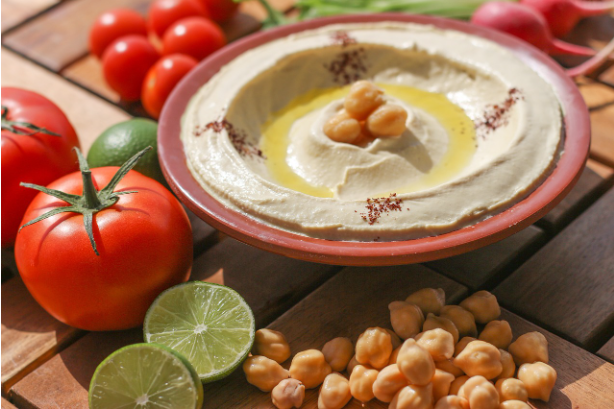Hummus
Middle Eastern countries including Egypt, Lebanon, Syria, and Israel all claim hummus as part of their culinary traditions. It’s gained global popularity in the last few decades.Hummus is regarded as a satiating and healthful appetiser or snack. It has a lot of fiber, protein, good fats, and several vitamins and minerals.A common Middle Eastern dip or spread, hummus is made with crushed sesame seeds, olive oil, lemon juice, garlic, and chickpeas, often called garbanzo beans.
-
Classic Chickpea Hummus:
Method:
- Soak 1 cup of dried chickpeas (also called garbanzo beans) overnight. Drain and rinse.
- In a pot, cover the chickpeas with water and bring to a boil. Reduce heat and simmer for 45-60 minutes until very soft.
- Drain the cooked chickpeas and reserve 1/4 cup of the cooking liquid.
- In a food processor, blend the chickpeas, 1/4 cup tahini (sesame seed paste), 2 tbsp lemon juice, 2 garlic cloves, 1/2 tsp cumin, and 1/4 cup of the reserved cooking liquid until smooth and creamy.
- Season with salt and pepper to taste. Drizzle with olive oil and sprinkle with paprika before serving.
Benefits:
Chickpeas are an excellent source of plant-based protein, fiber, complex carbs, and various vitamins and minerals like folate, iron, and magnesium. Tahini provides healthy fats from sesame seeds.
Nutrition (per 2 tbsp serving):
Calories 94, Fat 6g, Carbs 8g, Fiber 2g, Protein 3g
-
Roasted Red Pepper Hummus:
Method:
- Roast 2 red bell peppers over an open flame or under a broiler until charred on all sides. Let cool, then peel, seed, and chop.
- In a food processor, blend the roasted peppers, 1 can (15oz) of drained and rinsed chickpeas, 1/4 cup tahini, 2 tbsp lemon juice, 2 garlic cloves, 1 tsp cumin, and 2-3 tbsp water until smooth.
- Season with salt and pepper to taste. Drizzle with olive oil and sprinkle with smoked paprika before serving .
Benefits:
Roasted red peppers add a sweet, smoky flavor and antioxidants like vitamin C. The creaminess of hummus makes it a nutritious and satisfying dip or spread.
Nutrition (per 2 tbsp serving):
Calories 100, Fat 6g, Carbs 9g, Fiber 2g, Protein 3g
Edamame Hummus:
Method:
- Bring a pot of salted water to a boil. Cook 1 cup of frozen shelled edamame for 3-5 minutes until tender. Drain and let cool.
- In a food processor, blend the cooked edamame, 1/4 cup tahini, 2 tbsp lemon juice, 1 garlic clove, 1/2 tsp ground cumin, and 2-3 tbsp water until smooth and creamy.
- Season with salt and pepper to taste. Garnish with toasted sesame seeds, chopped cilantro, and a drizzle of olive oil.
Benefits:
Edamame is a great source of plant-based protein, fiber, and antioxidants like vitamin K and folate. This twist on classic hummus provides a vibrant green color and fresh, sweet flavor.
Nutrition (per 2 tbsp serving):
Calories 90, Fat 6g, Carbs 5g, Fiber 2g, Protein 4g
FAQs:
– Can I use canned or frozen edamame?
Yes, either of those work well. Just be sure to cook the frozen edamame first.
– How long will the edamame hummus keep?
It will last 4-5 days stored airtight in the refrigerator.
– What can I serve edamame hummus with?
It’s delicious with pita bread, veggies, crackers, or as a sandwich spread.
– Can I use canned chickpeas?
Yes, you can use 1 can of chickpeas. Drain and rinse before using.
– How long will hummus keep?
Stored in an airtight container in the fridge, it will last 4-5 days.
– Can I freeze hummus?
Yes, it freezes well for 2-3 months. Thaw in the fridge before serving.
– Can I use jarred roasted peppers?
Yes, that works too. Use about 1/2 cup chopped.
– How spicy is this hummus?
The roasted peppers add a mild sweetness, not much heat. Adjust spice with cayenne if desired.
– How long will the hummus keep?
It will last 4-5 days stored airtight in the fridge.
Written By:- Amisha


